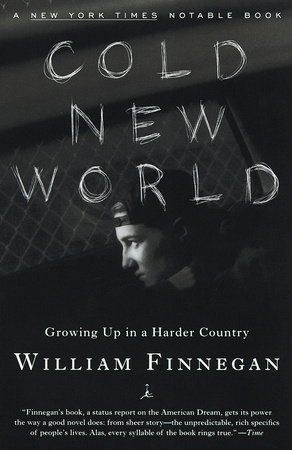Cold New World Reader’s Guide
By William Finnegan


1. Cold New World is about kids, families, and communities “caught in social and economic downdrafts.” The book cites evidence that the great American middle class has been shrinking since the 1970s, and offers various examples of a generation-long decline in economic opportunity for nonaffluent young people. (See, for instance, the lawyer Nancy Kelso’s speech on p. 323.) Meanwhile, many of our politicians and pundits extol the current health of the American economy. So, is Finnegan simply pointing out the empty fraction of a mostly full glass? What factors do you think account for these sharply different descriptions of the state of the American Dream?
2. The Sunday Times of London called Cold New World “a landmark account of teenage alienation in America.” After reading the book, do you feel any closer to understanding the more bizarre and frightening attitudes and behavior sometimes manifested by young Americans?
3. What does Finnegan mean when, after taking readers on his national tour of sometimes-alarming youth subcultures, he writes, “They connect private and public life” (p. 349)?
4. Terry Jackson’s decision to become a drug dealer is first described in terms of a powerful economic opportunity that suddenly presents itself to a child of grinding poverty (p. 9-16). Terry himself describes the excitement of the dealer’s life, including the girls who come with it. The author, meanwhile, analyzes the consumerist values that dominate the young dealer’s world (p. 58-59). Then Virginia Henry, an older anti-drug activist, offers her very different view of these matters (p. 59-60). Whose description of the illegal drug trade–its morality, its allure–seems most persuasive?
5. The “Deep East Texas” section of Cold New World is, in part, about a disappearing way of life, represented here by Nathan Tindall. The sheriff’s election becomes a kind of referendum on this way of life. Who did you find yourself rooting for as San Augustine County went to the polls? Why?
6. Laverne Clark has a sharp, specific sense of local history and black dispossession in the rural South (p. 112). Her daughter Lanee Mitchell has a radically different view of the past and its significance (p. 125-131). What factors account for this philosophical difference? Finnegan clashes with both women at points. Whose arguments did you find stronger when the topic was unwed motherhood (p. 132-136) or Anita Hill (p. 184)? And where did your sympathies lie when Finnegan refused to corroborate Lanee’s story about beating her son (p. 194)?
7. Why do you think the commanders of Operation White Tornado decided to pounce when they did (p. 156-157)?
8. In the Yakima Valley, Rafael and Rosa Guerrero pursue the immigrants’ dream of una vida mejor with great determination. Why does Juan not share his parents’ faith in the farmworkers’ union as a vehicle for their hopes? And what does it mean when Finnegan writes, “Juan’s anomie was not Third World but thoroughly American” (p. 246)?
9. Is Don Vlieger’s lecture on youth gangs (p. 220-224) persuasive? Does Juan’s experience with gangs–or Mary Ann Ramirez’s experience (p. 240-243; p. 259-261)–tend to confirm or contradict Vlieger’s analysis?
10. Juan and Mary Ann break up after he feels he has to make a choice between her and his (male) friends. When they get back together in Texas, Juan seems to appreciate his own good fortune. But then their story ends on an ominous note. What do you think happened next? And what model of the family and of communal responsibility is Juan substituting for his parents’ traditional campesino sense of village solidarity?
11. The Los Angeles suburbs of the Antelope Valley have suffered a long string of hate crimes. Finnegan observes (p. 273) that the downward social and economic mobility of many of the valley’s white residents, combined with upward mobility among the area’s blacks and Latinos, has provided the spark, the charged atmosphere, for many of these crimes–some white youths, in particular, cannot abide this reversal of standard race-caste roles. Do you find this a persuasive explanation of the strange popularity of white supremacism among kids in the Antelope Valley? What other forces might lead young people to join a gang such as the Nazi Low Riders?
12. Mindy Turner has been through an extraordinary number of “phases” by the time she turns fourteen–hippie, hesher, would-be Jew, Mormon convert, neo-Nazi. What do you think drives her? And why does she continue to be attracted–even after many bad experiences–to racist, violent men?
13. The damage that crystal methamphetamine does to both individuals and communities becomes obvious in “The Unwanted” section of Cold New World. Is the drug itself the problem? Or do you see it as primarily a symptom of social malaise? Is criminalization the best policy response? Or would treating crystal meth (and other dangerous drugs) as a public-health problem ultimately yield better results?
14. Do you agree with the district attorney’s decision not to prosecute Darius Houston for killing Jeff Malone (p. 334)?
15. Are you persuaded by Finnegan’s arguments against the existence of a “culture of poverty” (p. xxi, 135, 361, 378-379)? Does Dr. James Comer’s description (pp. 44-45) of the early realization among poor children that they are not being prepared to compete in the mainstream economy ring true? What social policies might help stem the loss of so many young Americans to drugs, prison, and poverty?
16. Finnegan clearly got quite close to many of the people he writes about in Cold New World. Do you think that, on the whole, this improved his understanding or undermined his objectivity?
Just for joining you’ll get personalized recommendations on your dashboard daily and features only for members.
Find Out More Join Now Sign In